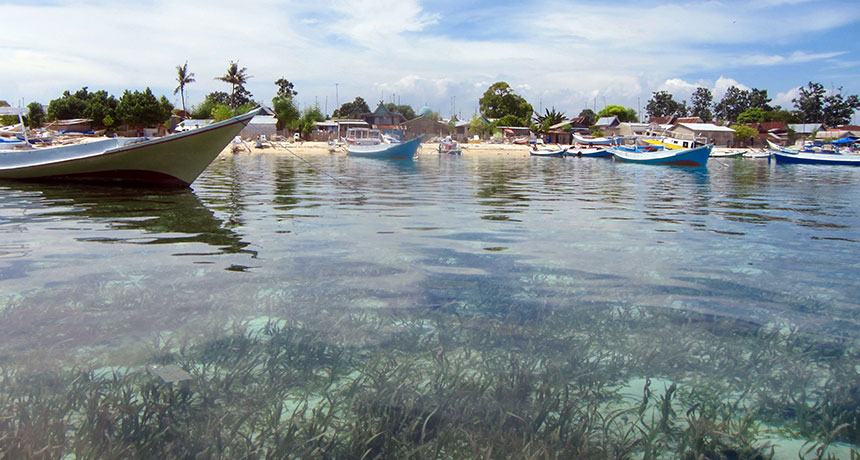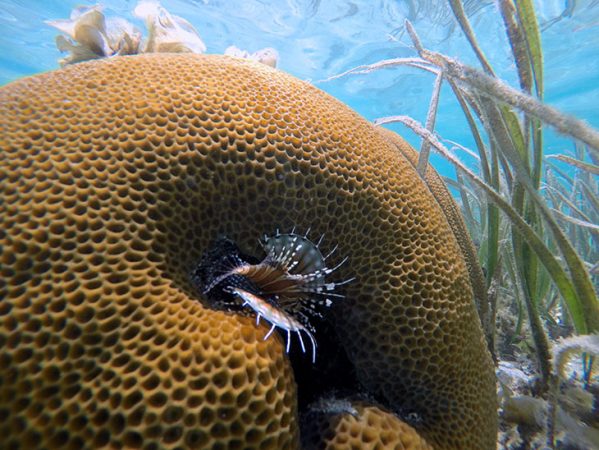Underwater meadows appear to fight ocean germs
Seagrasses limit near-shore bacteria to help keep aquatic neighbors healthy, new data show

Seagrasses, like those seen here, grow in shallow seas. They also help the environment by reducing the level of harmful germs in the surrounding water.
Joleah Lamb
BOSTON, Mass. — Want a lawn that needs no mowing and helps the environment? Look no further than the coastal ocean. Meadows of underwater seagrasses lower the amounts of harmful bacteria that can be found in coastal waters. That’s the finding of a new study reported here, February 16, at the annual meeting of the American Association for the Advancement of Science.
The findings suggest that nurturing healthy seagrass beds throughout coastal waters could make the whole ecosystem healthier — from corals and fish to people.
Seagrasses are not truly grasses. They are flowering plants with long, narrow leaves. Found in shallow ocean waters, they can spread to form vast underwater lawns. These plants are “a marine powerhouse, almost equal to the rainforest,” says says Joleah Lamb, an author of the study. “They’re one of the largest stores of carbon in the ocean,” the ecologist says. “But they don’t get a lot of attention,” she adds. Lamb works at Cornell University, in Ithaca, N.Y.
It’s no secret that seagrasses improve water quality, says James Fourqurean. He’s a biologist at Florida International University in Miami and wasn’t involved in the research.
Scientists had known these plants are great at removing excess nitrogen and phosphorus from coastal waters. Those are nutrients that often run off of the land, polluting coastal waters. Now, it seems, seagrasses might take away harmful germs, too. Lamb’s team describes its findings in the February 17 Science.
What pointed them to the value of these plants
A few years ago, Lamb’s colleagues became ill while studying coral reefs in Indonesia. This archipelago nation straddles the Indian and Pacific oceans. When a city or village on one of the country’s thousands of islands dumps raw sewage into the ocean, shoreline bacteria populations can spike to dangerous levels. So dangerous, in fact, that they gave Lamb’s colleagues a serious diarrheal disease known as amoebic (Uh-MEE-bik) dysentery.
Water sampled close to the shore off of four small and densely populated islands there had 10 times as many Enterococcus bacteria as the U.S. Environmental Protection Agency deems an acceptable limit. These germs can cause illness in people. Moreover, their presence often signals the likelihood that other disease-causing germs also may be around. But water collected from tidal flats and coral reefs that hosted healthy seagrass beds had far lower levels of the bacteria than did similar sites fewer than 20 meters away. The difference between these sites? The germy ones had no seagrasses!
The water where seagrasses grew also had lower levels of numerous bacterial species that can make fish and marine invertebrates (such as corals) sick. And surveys of more than 8,000 coral heads showed that those growing next to or inside seagrass beds had fewer diseases than those growing farther away.
(Story continues below image)

It’s unclear how far from seagrass beds this cleaner water extends. But the plants’ benefits can ripple through the entire ecosystem, Lamb said at the news conference at the AAAS meeting. What’s more, healthier corals help protect nearby islands from erosion. And fish hosting fewer bacteria make a healthier source of food for people.
Lamb is now planning follow-up studies. She hopes they will show her exactly how these ocean plants clean the water. Like a shag carpet, seagrasses can trap small drifting particulates. This trapping can keep those pollutant bits from flowing on. The plants might ensnare bacteria in the same way, building up biofilms on their blades. Or, she suggests, the leaves could be giving off some germ-killing compounds.
The new findings are one more reason to conserve seagrasses, study coauthor Jeroen van de Water said at the meeting. He’s an ecologist at the Scientific Center of Monaco. Globally, seagrass beds are declining by 7 percent each year. Both pollution and habitat loss are contributing to their loss. Efforts are underway in some areas to restore these underwater lawns. Still, Lamb argues, “it’s better to stop what we’re doing to the meadows than to try to replant them.” Indeed, she points out: “It’s hard to start doing restoration projects if the environment isn’t exactly what the seagrass prefers.”







